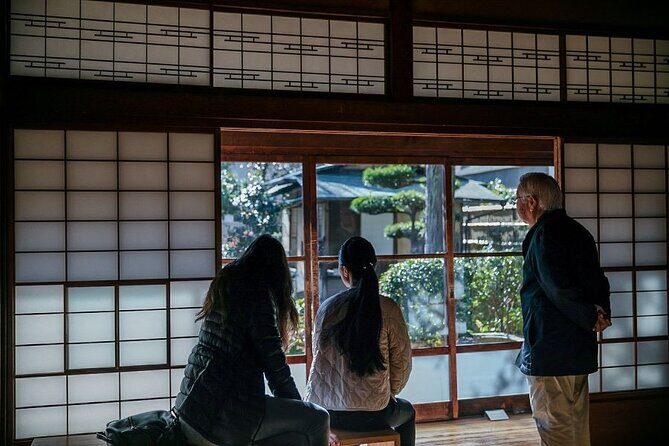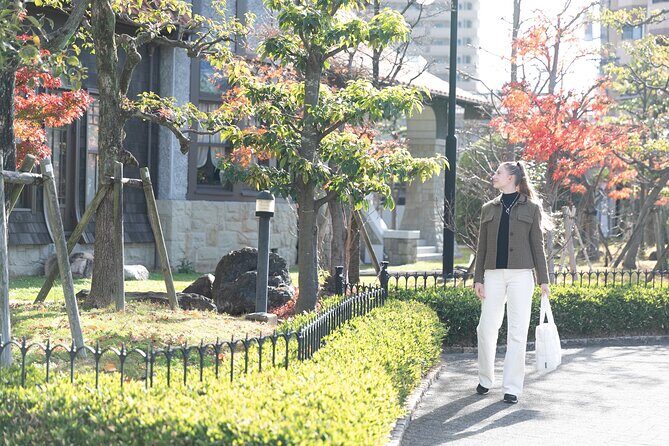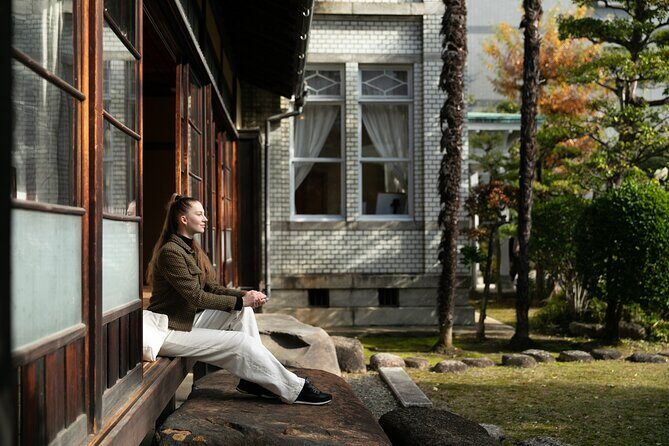Nagoya Culture Path: Tour of Three Cultural Properties – A Deep Dive into Local Heritage

If you’re craving a meaningful look into Nagoya’s past, this Nagoya Culture Path tour offers a compact yet enriching experience. For around $106.70 per person, you gain access to three carefully selected sites, each revealing a different facet of Nagoya’s cultural landscape. The tour lasts about two hours, making it a perfect quick immersion for those with limited time but a strong interest in authentic Japanese heritage.
What we really love about this experience is the chance to step inside buildings that are usually closed to the public—especially the Bunka no Michi Namiki-kan tea room, where you get to enjoy matcha and sweets in a serene, historic setting. Also, visiting the Toyoda Sasuke House, the residence of a key figure in Nagoya’s industrial history, adds a personal touch to the journey, connecting you to local stories of business success and family legacy.
A possible consideration is that the tour covers a fair amount in a short time, which means some sites might feel slightly rushed. Still, if you’re someone who appreciates a well-organized, focused visit with a knowledgeable guide, this is likely a perfect fit. It’s especially suited for travelers keen on history, architecture, and traditional Japanese gardens, looking for an authentic experience that goes beyond surface-level sightseeing.
This tour is ideal for those who enjoy cultural storytelling, and it’s well suited for solo travelers, couples, or small groups eager to explore Nagoya’s lesser-known gems without the hassle of planning individual visits. If you want a guided, meaningful peek into Nagoya’s heritage in a manageable time frame, this tour delivers.
Key Points

- Historic Sites: You visit notable properties like the Cultural Path Shumokukan and the Toyoda Sasuke House, both rich with stories.
- Exclusive Access: The Bunka no Michi Namiki-kan tea room is usually off-limits, making this a rare opportunity to experience traditional tea ceremonies.
- Beautiful Gardens: The Hyakka Hyakuso garden features approximately 70 of the 90 types of flowers depicted in a famous cultural screen, offering a colorful, seasonal visual feast.
- Authentic Atmosphere: Each location preserves its unique ambiance, from Western-style buildings to Japanese-style residences, offering a true taste of local history.
- Concise but Content-Rich: The two-hour format packs in history, architecture, and culture without feeling rushed.
- Value for Money: While the price may seem modest, the inclusion of entry tickets, guided commentary, and the special tea experience make it a compelling deal.
Planning more time in Nagoya? We've covered other experiences worth considering.
A Detailed Look at the Nagoya Culture Path Tour

Starting Point: Cultural Path Shumokukan
We begin at the Cultural Path Shumokukan, a site that once served as a residence for Mr. Iimoto Tamesaburo. The complex includes a two-story Western-style building, a modest Japanese-style building, and two warehouses, all set around a tranquil garden. The Western building is particularly striking—fitted out with elements that hint at its diplomatic and commercial past, such as stained glass windows and Western-style toilets and baths. These features reveal how Nagoya’s elite embraced modernization early on.
What we appreciated is the way the guide explained how this house was used for ceramics export negotiations and foreign visitors, giving us a sense of Nagoya’s role in global trade. The 30-minute visit feels just right to absorb the atmosphere and admire the architecture without feeling rushed.
Next Stop: Toyoda Sasuke House
From there, we moved on to the Toyoda Sasuke House, the only remaining residence of Sasuke Toyota, brother to the famous Sakichi Toyota. This white-tiled Western-style home, likely built around 1923, stands as a testament to Nagoya’s industrial rise. The spacious Japanese-style house nearby complements the Western building, illustrating the blend of traditional and modern influences.
Inside, we loved the details—lotus-shaped lighting and the decorations with Toyoda characters and cranes—which give a glimpse into the family’s pride and aesthetic. We heard from a review that the residence’s ornate decorations add a personal touch, making it more than just a historical relic. The tour is free here, which is a bonus, and it’s an opportunity to appreciate Nagoya’s progressive family roots.
Final Stop: Hyakka Hyakuso Garden and Tokugawa Art Museum
The third site is the Hyakka Hyakuso, part of the Tokugawa Art Museum complex. After a careful renovation completed in 2007, this garden is inspired by the Hyakki Yagyo-zu Byobu screen, an Important Cultural Property. The garden is alive with approximately 70 flower varieties, providing a lush, ever-changing visual.
While enjoying tea and piano performances in the hall overlooking the garden, we felt a peaceful connection to the art and nature. The self-serve tea setup makes you feel at ease, and the garden’s seasonal blooms—represented in the screen—make every visit different. The 50-minute stay here is perfect for savoring the scenery and the quiet beauty of Nagoya’s traditional gardening.
- From Nagoya: Crafting Traditions in Tokoname and Arimatsu
- From Nagoya: Inuyama Castle, Ena Gorge, Magome, Tsumago Tour
- From Nagoya: Hida Takayama and Shirakawa-go Winter Day Tour
- From Nagoya: Ises Sacred Shrines and Captivating Coastlines
- From Nagoya: Hida Takayama and World Heritage Shirakawa-go
- From Nagoya: Castles and Canals in Hikone and Omi Hachiman
Practical Details and Tips

The tour begins at 1:00 pm at the Cultural Path Shumokukan and ends at the Hyakka Hyakuso. The stops are close enough that transportation isn’t a concern, and the guide provides a seamless experience.
Since this is a private tour, your group gets personalized attention, which enhances the overall experience. The price includes all admission fees for the sites, making it straightforward—no hidden costs. And you can cancel free of charge up to 24 hours before, adding some flexibility if plans change.
Be prepared for a fair amount of walking and standing, especially at the gardens and residences. The tour is accessible for most travelers, but comfortable shoes are recommended.
Why it’s worth considering
If you’re a history buff, architecture enthusiast, or simply love exploring local stories in depth, this tour offers authentic insights into Nagoya’s development. It’s less about crowds and more about quietly soaking in the atmosphere of genuine cultural properties. It’s especially rewarding if you’re curious about how Nagoya’s past influences its present.
Final thoughts: Who should book this tour?
This experience is perfect for travelers who want a meaningful, guided glimpse into Nagoya’s history and culture. It suits those who appreciate architecture, gardens, and traditional tea and prefer an intimate, well-organized outing. If you’re looking for a quick, enriching experience with a local flavor, the Nagoya Culture Path will serve you well.
However, if you crave a more comprehensive or high-energy tour, or prefer a larger group setting, you might find this format a bit too quiet or focused. For most, though, it’s an excellent way to connect authentically with Nagoya’s past in a manageable and rewarding way.
FAQ
Is this tour suitable for children?
Yes, children who can walk and tolerate a walking tour will enjoy exploring the historic buildings and gardens. The itinerary is not overly strenuous.
Are there any additional costs?
No, all admission tickets are included in the price. However, if you wish to purchase souvenirs or extra snacks, those are not covered.
How long does each site visit last?
The visit to Shumokukan lasts about 30 minutes, Toyoda Sasuke House about 40 minutes, and Hyakka Hyakuso around 50 minutes, making the total close to two hours.
Is the tour wheelchair accessible?
The tour is designed for most travelers, but since some historic buildings and gardens may have uneven surfaces or steps, it’s best to confirm accessibility details with the provider.
What should I wear?
Comfortable shoes are recommended given the walking involved. Casual attire suitable for moderate activity, and a hat or umbrella in warmer weather, would be wise.
Can I join this tour if I don’t speak Japanese?
Yes, the guide speaks English, and the tour is designed to be accessible for non-Japanese speakers interested in cultural history.
In capturing Nagoya’s lesser-known gems, this tour offers an authentic, immersive experience that appeals to history lovers and culture seekers alike. It balances informative storytelling with beautiful sights, making it a worthwhile addition to any Nagoya visit.
More Tours in Nagoya
- Tenugui Dyeing Experience Tour from Nagoya with English Guide
- Private Full Day Magome &Tsumago Walking Tour from Nagoya
- Day Trip Gifu Highlight Tour by Public Transportation from Nagoya
- Guided Half-day Tour(PM) to Toyota Commemorative Museum & SCMAGLEV Railway Park
- Nagoya: all-inclusive car tour to Korankei valley
- Specialties of Nagoya Food Tour
More Tour Reviews in Nagoya
- Brass Bangle Crafting with a Master Artisan in Historic Nagoya
- Tenugui Dyeing Experience Tour from Nagoya with English Guide
- Private Full Day Magome &Tsumago Walking Tour from Nagoya
- Day Trip Gifu Highlight Tour by Public Transportation from Nagoya
- Visit three major sightseeing sites efficiently in Nagoya in one day
- Guided Half-day Tour(PM) to Toyota Commemorative Museum & SCMAGLEV Railway Park
More Nagoya experiences we've covered
- Brass Bangle Crafting with a Master Artisan in Historic Nagoya
- Tenugui Dyeing Experience Tour from Nagoya with English Guide
- Private Full Day Magome &Tsumago Walking Tour from Nagoya
- Day Trip Gifu Highlight Tour by Public Transportation from Nagoya
- Visit three major sightseeing sites efficiently in Nagoya in one day
- Guided Half-day Tour(PM) to Toyota Commemorative Museum & SCMAGLEV Railway Park
- Nagoya: all-inclusive car tour to Korankei valley
- Shirakawa-go from Takayama/Nagoya One day Bus ticket
- Specialties of Nagoya Food Tour
- Eat Like A Local In Nagoya: Private & Personalized
- Grandma’s Traditional Japanese Cooking Class
- From Nagoya: Samurai Swords and Japan Oldest Castle
